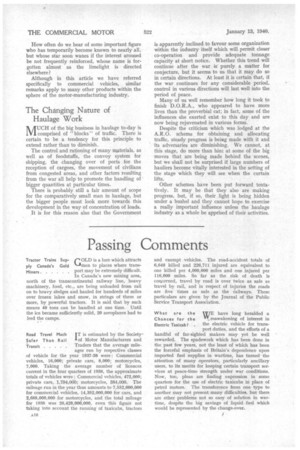Passing Comments
Page 18

Page 19

If you've noticed an error in this article please click here to report it so we can fix it.
GOLD is a lure which attracts ‘-amen to places where transport may be extremely difficult. In Canada's new mining area, north of the transcontinental railway line, heavy machinery, food, etc., are being unloaded from rail on to heavy sledges and hauled for hundreds of miles over frozen lakes and snow, in strings of three or more, by powerful tractors. It is said that by such means 40 tons can be handled at one time. Until the ice became sufficiently solid, 20 aeroplanes had to feed the camps. Tractor Trains Supply Canada's Gold
Miners IT is estimated by the Society of Motor Manufacturers and Traders that the average mile
ages run by respective classes of vehicle for the year 1937-38 were : Commercial vehicles, 16,000; private cars, 8,000; motorcycles, 7,000. Taking the average number of licences current in the four quarters of 1938, the approximate totals of vehicles were : Commercial vehicles, 472,000; private cars, 1,794,000: motorcycles, 384,000. The mileage run in the year thus amounts to 7,552,000,000 for commercial vehicles, 14,352,000,000 for cars, and 2,688,000,000 for motorcycles, and the total mileage for 1938 was 26,428,000,000, even this figure not taking into account the running of taxicabs, tractors
and exempt vehicles, The road-accident totals of 6,648 killed and 226,711 injured are equivalent to one killed per 4,000,000 miles and one injured per 116,000 miles. So far as the risk of death is concerned, travel by road is over twice as safe as travel by rail, and in respect of injuries the roads are five times as safe as the railways. These particulars are given by the Journal of the Public Service Transport Association.
What are the WE have long heralded a
Chances for the VY reawakening of interest in
Electric Taxicab . the electric vehicle for trans port duties, and the efforts of a handful of far-sighted makers may yet be well rewarded. The spadework which has been done in the past few years, not the least of which has been the forceful emphasis of Britain's dependence upon imported fuel supplies in wartime, has turned the attention of many operators, particularly ancillary users, to its merits for keeping certain transport services at peace-time strength under war conditions. Now, too, pleas are finding expression in some quarters for the use of electric taxicabs in place of petrol motors. The transference from one type to another may not present many difficulties, but there are other problems not so easy of solution in wartime, despite the big savings of liquid fuel which would be represented by the change-over. A Good Example of IT has been the practice of the Patriotic Generosity 'Automotive Products Co., to Employees . . . Ltd., to pay, just before
Christmas, a bonus to all employees of the affiliated companies—that named, Lockheed and Borg and Beck. So far as the works and junior office staff are concerned, this .has taken the form of an additional week's salary. On this occasion, however, in addition to the bonus mentioned, the directors of the company are giving the approximate equivalent of a further week's salary in National Savings Certificates, with a note to the effect that they hope this will provide an incentive to further saving during the year. The extent of this appreciation of good service can be realized when we mention that the companies have nearly 3,000 employees.
Peace time Lighting piTZEVAILING black-out con for Public service ditions make the issue of a Vehicles book on the illumination of public-service vehicles appear to be almost humorous, but the interim report on this matter, issued by a joint committee of the P.S.T.A., M.P.T.A., O.O.A. and S.M.M. and T., which is published at 5s., is a valuable contribution to peace-time conditions. It recommends that an average general illumination of 3.5 ft-candles should be provided within a "working space" for reading. This compares with the 0.1 ft-candle at present allowed in buses, which was raised from the original 0.006. The report includes the results of many investigations by illumination experts, and deals with fittings, reflection factors, mounting, level of lighting, lamp calibration, etc.




























































